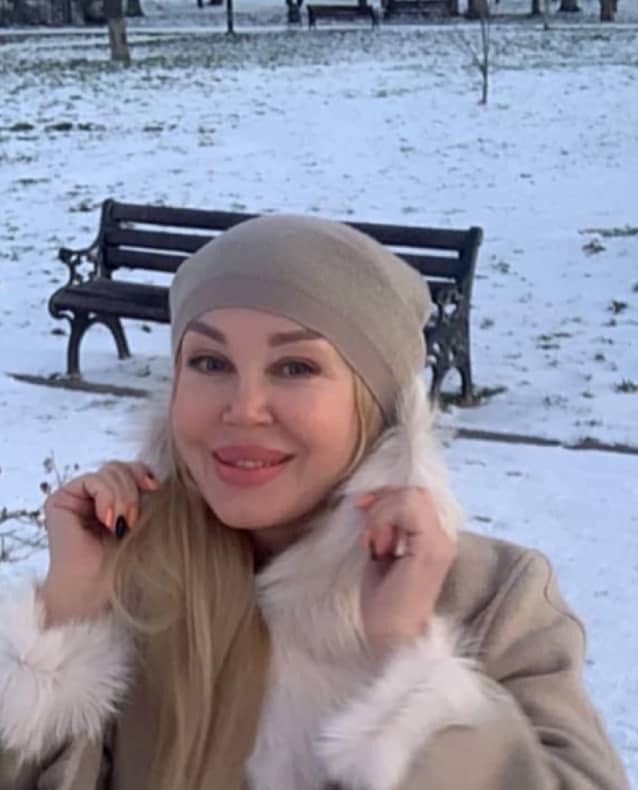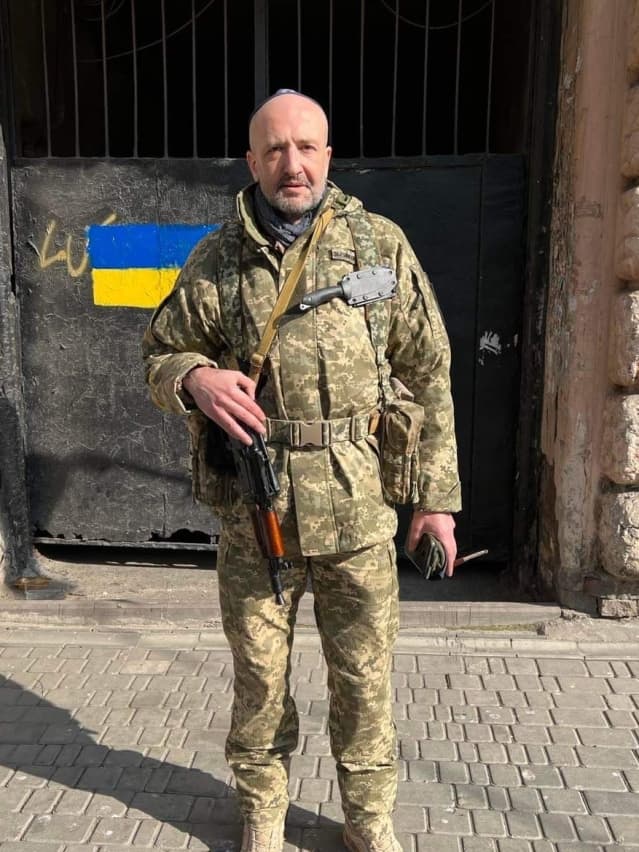This post was originally published on this site
ODESSA, Ukraine — When the first bombs landed on Ukraine’s southern port city of Kherson in the early morning of Thursday, Feb. 24, Father Maxim Kapelan knew exactly what to do.
A 39-year-old Ukrainian Orthodox priest who administered a small congregation from the Nativity of the Blessed Virgin Church in Daryivka village outside the southern city of Kherson, he leapt out of bed and immediately went through steps drilled into him after weeks of training.
Soon he was in full battle fatigues, gathered with 20 comrades from the 124th Territorial Army battalion at a nearby arms depot. As they distributed automatic weapons, a squadron of four Russian helicopters flew in and attacked them.
They fled into the woods, escaping with only a few injuries before a larger helicopter squadron returned and flattened the depot. It was a sunny morning, an early spring day, the start of a horrific new chapter in Father Maxim’s life and a turning point in modern European history.
“Those first three days flew by like one,” he told MarketWatch. “There was no time for sleep, for eating or even for praying.”
“‘Those first three days flew by like one. There was no time for sleep, for eating or even for praying.’”
Around the same time, interior designer and shop owner Lilia Bushina was in her apartment building in downtown Kherson, huddled with neighbors in a windowless communal corridor, glued to her screen. Within minutes of the early morning bombardments, Ukraine’s social-media space filled up with images and videos of devastation.
As the muffled thuds of artillery and crackle of gunfire filled the corridor, Lilia said, she was in a state of shock, struggling to accept the terrifying fact that Putin had done what she thought he never would do.
“There’s no justification for it. We all speak Russian in Kherson,” she told MarketWatch on Tuesday. “No one’s ever been discriminated against here. There are no Nazis here. We never asked Russia to save us.”
Kherson is a ship-building city with a population of 280,000 before the Russian invasion, positioned at the confluence of Ukraine’s biggest river, the Dnieper, with the Black Sea. Tree-lined and sleepy, it’s one of the many balmy coastal towns along the Black Sea that have recently been upgraded for tourism.
“It’s a pleasant, small city with lovely restaurants and great leisure activities on the river,” Lilia said. Kherson was the first Ukrainian city to fall to Russian forces.
Kherson’s strategic importance is partly due to the wide river-supply route that snakes north through important staging towns such as Zaporozhye, Dnipro, and Ukraine’s capital, Kyiv. Its proximity to Russia-controlled Crimea, only 80 miles away, also makes it an important prize for the invading force.
The only access point to Kherson from the East is across the Antonivka Bridge, on the edge of Kherson town. Over a kilometer long, the bridge was the first major target for Russian forces arriving from Crimea later in the morning.
“‘The most frightening sound was of the bomber jets overhead. For days, all I felt was fear.’ ”
Like many people across Ukraine, Father Maxim believes he has no choice but to fight in what is an existential war — and he sees no contradiction in his dual life as a fighter and a priest.
This is captured on his social-media profile, where photos show him as both a swarthy warrior in battle fatigues and a nurturing pastor in an ankle-length cassock. “Even though I’m a priest, I have the full moral right to take up arms to defend my people and my family,” he said.
By 9 a.m., five hours after the first bombardments jolted him from sleep, Father Maxim and most of Kherson’s 500 territorial army corps had taken up positions behind a settlement of a couple of hundred residential houses west of Antonivka Bridge. Nearer the bridge was their front guard, a force of about one thousand regular Ukrainian army troops.
Across the river, a sizable Russian army arrived and started lobbing heavy artillery rounds at their positions. Intense fusillades of Grad rockets followed soon after, 40 at a time, pockmarking the entire settlement and destroying most of the buildings within hours. Civilians, escaping in cars, were strafed by automatic gunfire.
The majority of civilian and military casualties happened on the first day. According to eyewitnesses, dead bodies were everywhere.
“You can’t fight Grad rocket barrages, so we fled into the fields behind Antonivka village,” Father Maxim said. “Later we went to the local school, where we started helping people evacuate.”
For four days, the Ukrainian army fought for control of the bridge against a much bigger and better equipped Russian army, even taking the bridge back on day two.

Lilia Bushina on the Russian bombardment of Kherson: ‘They destroyed the military buildings in the city. Apartment blocks were attacked. They even bombed the central market.’
Courtesy Lilia Bushina
On the fifth day, however, they were finally overwhelmed and forced to retreat to the nearby city of Nikolaev. The Russians spilled over the bridge, attacked Kherson’s international airport and surrounded the city of Kherson. They also followed the retreating Ukrainian army to Nikolaev.
Merged with a larger force, the Ukrainians stood their ground outside Nikolaev’s main airport and formed what is now the new front line in the battle for Ukraine’s south coast.
Although it’s difficult to know the exact numbers of Ukrainian casualties, Father Maxim said that more than 300 Ukrainian soldiers of the regular army were killed defending the bridge. Despite this, Father Maxim’s territorial army battalion continued the fight against the Russians on the outskirts of Kherson.
“There were about 500 of us, but we had no artillery — only automatic weapons,” he said. “The Russians fanned out, surrounded the city, and within hours, they were coming at us from every direction. In the street battles that followed, we lost another 50 men.”
And yet Yuri Voloshin, a buoyant 52-year-old Jewish lawyer fighting with Odessa’s territorial army, remains steadfastly optimistic. Donning a yarmulke and full battle fatigues, an AK-47 proudly slung over his shoulder, he told MarketWatch at his local synagogue that he believes the Russians are demoralized.
“Half of them don’t want to fight,” he said. “The others don’t know where they even are.”
Throughout the early days of the Russian invasion, Lilia continued huddling with her neighbors in the corridor.
“I didn’t leave the house for days — just stayed at home like mice. It was terrifying,” she said. “They destroyed the military buildings in the city. Apartment blocks were attacked. They even bombed the central market. The most frightening sound was of the bomber jets overhead. For days, all I felt was fear.”
Once the Russian army had secured Kherson, Russian police, OMON interior ministry troops and an assortment of Crimean civilians flooded into the city. Kherson’s mayor was forced to accept Russian military rule but was surprisingly allowed to keep the Ukrainian flag flying over the central administration buildings.
“Tens of thousands of people have been without water or food for days. Many of them are elderly or sick. ”
In the first two days after the Russians took control, chaos ruled. The Russians stole people’s cars and looted mobile-phone shops, locals said. Even Lilia’s small grocery store was ransacked, she told MarketWatch. The town was closed off. Almost a week later, nobody has left or entered Kherson since.
“The enemy is not even allowing deliveries into Kherson,” Vadym Denysenko, adviser to the Minister of Internal Affairs, said. “When people try to get in, the Russian military personnel stop them, fire at them, throw them out of their cars and intimidate them.”
Maxim and his 450 comrades have gone to ground. “We know they’re looking for us and they know who we are,” he said. For now, all they can do is wait, keep a low profile and share updates with one another.
Despite the ongoing threat, the people of Kherson have been bravely flooding into the city center square every day bearing Ukrainian flags, chanting at Russian military police and protesting their presence.

Yuri Voloshin is a veteran of two wars, including the Nagorno Karabakh conflict in 1989 and Ukraine’s 2014 war against Russian-backed separatists in the Donbas.
Credit: Johnny O’Reilly
Across the country, small towns under Russian control are experiencing worse. The situation is critical in Kharkiv, Mariupol and the satellite towns of Bucha, Vorzel and Gostomel outside Kyiv. Tens of thousands of people have been without water or food for days. Many of them are elderly or sick.
The Russians are refusing to organize “green corridors” to allow civilians to leave, Denysenko told the people. This decision to purposefully make life worse for civilians is consistent with Russia’s warfare playbook from previous campaigns in both Chechnya and Syria. “From what we can understand, this is the personal instruction from Vladimir Putin,” Denysenko said.
Despite the evolving horrors of this escalating war, Ukrainian morale appears to remain high. Thirteen days after the invasion, battlefronts around Kyiv, Kharkiv, and Sumy are still in a stalemate. The whole country has mobilized to aid the war effort.
Donations of clothing, food, electronics and medicine are flowing into volunteer centers in every district of every town. Traffic jams with relief trucks from all parts of Europe are forming at entry points into Ukraine as people across the continent answer Ukraine’s call to action.
Victory for Russia is by no means guaranteed, but it’s becoming clear that control over the skies is the difference between the two sides. Ukrainian President Volodymyr Zelensky is pushing hard to change international public opinion over the implementation of a no-fly zone.
Western leaders have made it clear that this is not in the cards, but the calculation is that with enough public pressure, Eastern European countries such as Poland and Bulgaria might be persuaded to strengthen Ukraine’s air force by providing jet fighters.
A veteran of two wars, including the Nagorno Karabakh conflict in 1989 and Ukraine’s 2014 war against Russian-backed separatists in the Donbas, Yuri Voloshin is now fighting his third.
He had a word of advice for Western leaders: “Give us control of our skies, and we’ll be celebrating a Ukrainian victory in the streets of Moscow.”
Johnny O’Reilly is a writer and filmmaker based in Ukraine.
Related:
War in Ukraine: Russia lays siege to Mariupol, civilians ‘effectively taken hostage’

